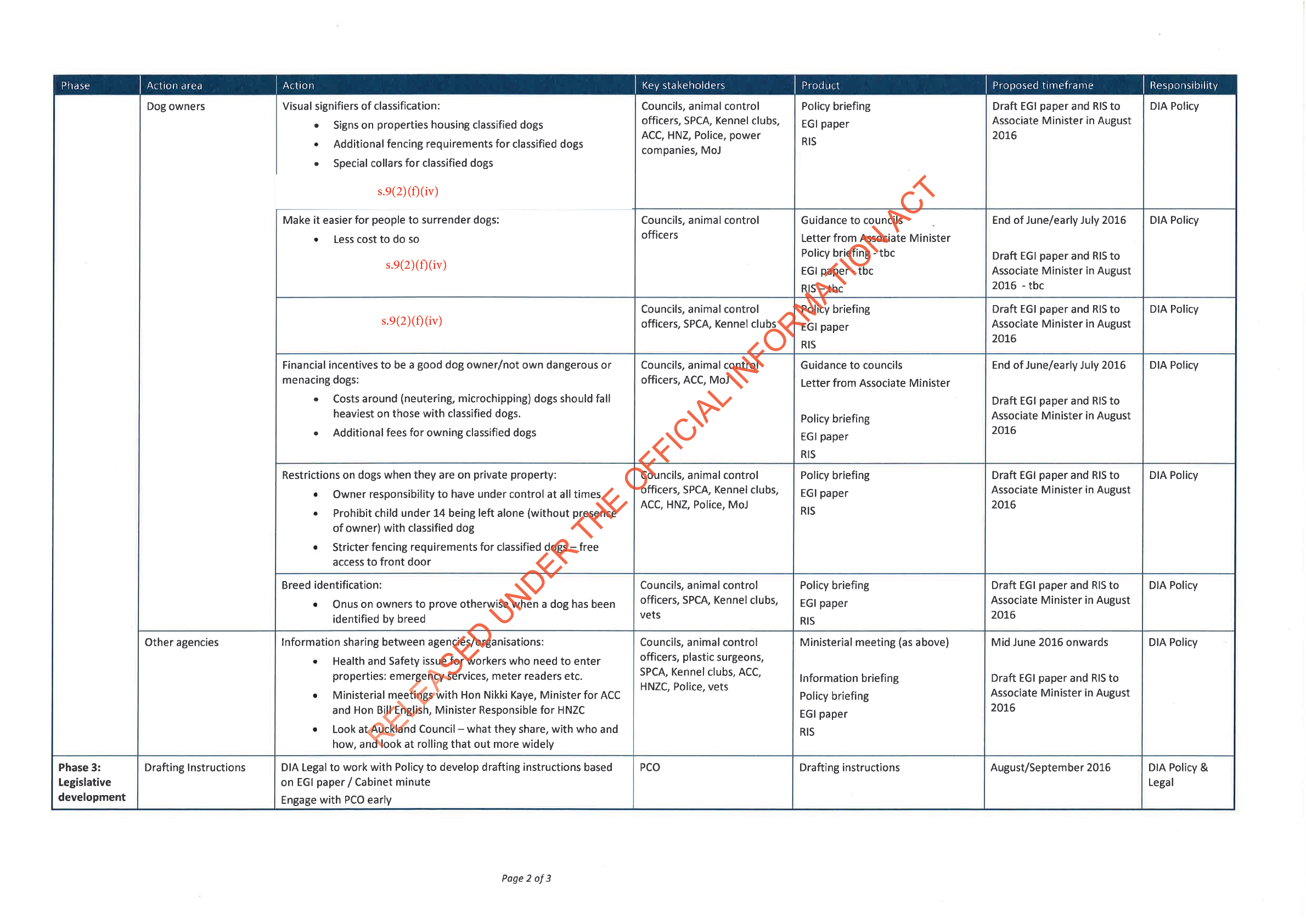
Document 1
Hon Louise Upston
Associate Minister for Local Government
Private Bag 19041
Parliament Buildings
Wellington
ACT
2nd May 2016
Recommendations to Decrease Dog Attacks in New Zealand
The purpose of this report is to present areas within the Dog Control Act 1996 (the Act) that the New
Zealand Institute of Animal Management Inc. (NZIAM) have concerns with and strongly recommend
be strengthened, along with additional provisions to allow for improved dog control service and
increased public safety.
INFORMATION
This report also reiterates the concerns raised in the earlier reports presented to the then Ministers
for Local Government – The Honourable Paula Bennett – on the 16th April 2014 and The Right
Honourable Rodney Hide – on the 13th April 2011 along with introducing additional recommendations
for improved community safety
Four Points identified for immediate attention:
1. Mandatory notification of dog bites to Territorial Authorities
2. Industry national standards
3. Legislation review
4. National education programs in schools
THE OFFICIAL
1. Notification of Dog Bites
The Institute recommends the mandatory notification of all dog bite incidences reported through
the medical professions to Territorial Authorities.
Rationale – Statistical evidence shows that approximately 85% of dog bites reported to ACC are
SED UNDER
not reported to Territorial Authorities. Many of these incidents occur within the family home.
Mandatory reporting will allow territorial authorities to investigate and apply appropriate actions to;
a) educate dog owners on responsibilities of being a dog owner
b) prevent further attacks
RELEASED UNDER THE OFFICIAL
2. National Standards of Operation
The Institute recommends mandatory training of all Territorial Authority Dog Control Officers along
with national audit programs of Territorial Authority Animal Management operations
Rationale:
-
Animal Management Officer Training
At present there is no requirement for Territorial Authorities to train their Animal Management staff
to any level within any required timeframe. This in itself presents huge ramifications for consistent
application of dog control in New Zealand.
Under the Health and Safety Act Territorial Authorities are obligated to manage the risks to
ACT
Officers working in dangerous and high risk situations.
No consistent training standards result in inconsistent professional application of duty. This in turn
leads to total failure by some Territorial Authorities to apply the provisions of the Dog Control Act in
relation to dog attack situations.
The Skills Organisation have in place supporting capabilities for Animal Management Officers to
achieve recognised qualifications in the Animal Control field for both entry and advanced levels
with revised and renewed qualification levels available in the near future however there is no
mandatory requirement for the Officers to be trained at any level and where costs can be a factor
any training of the officers is therefore at times a secondary consideration.
INFORMATION
In order to provide a professional and safe animal management service, officers must be trained to
a national standard. Consistent understanding means consistent application and with that follows
clear messages to the community generally about best practice in terms of responsible dog
ownership. Responsible dog ownership leads to less serious dog attacks.
-
Auditing of Territorial Authority processes
Territorial Authorities have a responsibility for the safety of communities and those communities
THE OFFICIAL
have a right to receive professional services. Audit programs that provide checks and measures
of compliance along with actions for noncompliance will ensure that dog control operations
nationally are consistent and of a higher standard than at present.
3. Legislation Review
SED UNDER
The Institute recommend the Dog Control Act 1996 be reviewed to incorporate the following
points:
• Infringement Notice system for s57 (attacking) and s57A (rushing)
The ability to apply an infringement notice to an owner of any dog for biting or rushing at a
RELEASED UNDER THE OFFICIAL
person would serve as a deterrent to those who do not apply responsible dog ownership.
This provision would allow for a consequence where it may not be serious enough to
proceed to prosecution.
• Amendment to s57A (rushing)
Remove the words ‘public place’ to expand the offence to provide for rushing incidents on
private property.
• Probationary Owner classification additions
Add to the existing Probationary Owner provisions to provide a mandatory probationary
classification for any person who commits any offence under s57 and s57A. This will have
the accompanied effects of the classification including increased fees. A dog owner will be
required to attend a ”knowledge” program before the classification can be removed.
• De-sexing of all Menacing classified dogs
Mandatory requirement for all dogs classified as Menacing. At present it is optional for
Territorial Authorities.
• De-sexing of all Menacing and Dangerous classified dogs impounded
Mandatory requirement for all dogs classified as Menacing or Dangerous to be de-sexed
ACT
before release from any animal shelters. At present the owners of these dogs have 30
days to comply with any possible requirement to de-sex.
• No adoption of Menacing Classified dogs
Prohibit the ability for any dog listed in Schedule 4 of the Act to be adopted back into the
community from any animal shelter or welfare agency.
Rationale:
The above legislation reviews will assist in ensuring offending dog owners are made more
accountable for the actions of their dogs. It is not appropriate or acceptable for persons to own
INFORMATION
dogs that attack within the family home or wider communities.
De-sexing before release from shelters for Menacing and Dangerous dogs will reduce the ability
for indiscriminate breeding.
4. National education programs in schools
The Institute recommend that dog safety awareness programs in schools be made compulsory
and a part of the national education curriculum.
THE OFFICIAL
Rationale:
The incidences of dog attacks on children are increasing. A stronger awareness from children
regarding safe dog interaction practises will assist in reducing these attacks. Compulsory school
education programs will serve as a vehicle for delivering safety awareness techniques and an
increased knowledge of safe practises around dogs for both children and parents.
SED UNDER
Summary
The Institute is aware of the increased dog attack incidents in New Zealand and are best placed
as an organisation to offer recommendations for the improved safety of communities from dog
attacks.
RELEASED UNDER THE OFFICIAL
The above recommendations are considered to be vitally important if there is to be a shift in the
numbers of dog attacks.
Executive
New Zealand Institute of Animal Management
ACT
INFORMATION
THE OFFICIAL
SED UNDER
RELEASED UNDER THE OFFICIAL

Document 2
Councillors’ Office
Memo
19 May 2016
To:
Hon. Louise Upston, Associate Minister for Local Government
From:
Calum Penrose, Manurewa-Papakura ward councillor
ACT
Subject:
Initiatives to improve management of menacing dogs
Purpose
To summarise Auckland Council’s current initiatives to improve management of menacing
dogs and outline possible future legislative actions.
Menacing dog amnesty
On 21 April, Auckland Council launched an amnesty for menacing dogs to incentivise
INFORMATION
registration, micro-chipping, de-sexing, and muzzling of menacing dogs. The amnesty has
been publicly supported by SPCA, Housing New Zealand Police, and St Johns.
To date 335 dogs have been brought to Auckland Council under the amnesty. They have
received a combination of the services being offered. Of the 335 dogs brought forward, 268
are of the American Pit Bull Terrier type. The majority of the others are American
Staffordshire terriers and Rottweilers There is a significant regional division, with 201 of the
dogs in the southern suburbs (Howick, Manukau, Manurewa-Papakura, and Franklin wards).
THE OFFICIAL
The amnesty will end on 30 June. From 1 July, Auckland Council will target all unregistered
menacing dogs. Any unregistered dogs will be seized and all fines will be upheld.
Legislative options
Schedule 4 of the Dog Control Act 1996 lists four breeds and one type of dog that are
menacing and may not be brought into NZ. These are Brazilian Fila, Dogo Argentino,
Japanese Tosa, Perro de Presa Canario (breeds) and American Pit Bull Terrier (type). Dogs of
SED UNDER
owners convicted under section 57a are also classified as menacing; these dogs must be
desexed regardless of type.
Menacing dogs must be muzzled in public, yet there are limited legislative controls for dog
RELEASED UNDER THE OFFICIAL
de-sexing. Although the Dog Control Act makes it possible for territorial authorities to
require de-sexing, uptake is variable.
135 A bert Street | Private Bag 92300, Auckland 1142 |
aucklandcouncil.govt.nz |
Ph 09 301 0101
 Councillors’ Office
Councillors’ Office
There are three distinct shortcomings of current legislation in requirements for dog de-
sexing, dog classification, and owner registration.
Following advice from officers, I seek your leadership to amend the Dog Control Act (1996)
to require:
1. Compulsory de-sexing of menacing dogs prior to sale or distribution unless four
generation lineage is proven through the New Zealand Kennel Club.
Rationale: Not requiring compulsory desexing of menacing dogs has led to a proliferation of ACT
American Pit Bull Terrier types. Auckland Council already requires menacing dogs to be de-
sexed. Dogs classified as menacing by breed must be determined to be wholly or
predominantly of that breed. Owners have one month from the receipt of classification to
produce proof from a veterinarian that the dog has been de-sexed.
2. Specify by way of schedule to the Dog Control Act a formal, comprehensive and
consistent definition of schedule four breed and type dogs.
Rationale: The absence of a definitive, nationally applicable determination of American Pit
Bull Terrier types confounds menacing classifications, making applications highly variable
INFORMATION
across New Zealand. Auckland Council has provided information to the public to assist in
identifying a dog as having American Pit Bull Terrier type physical traits.
3. Require the certification of owners of menacing dogs (as per schedule 4).
Rationale: The absence of compulsory registration for owners of menacing dogs results in
individuals unsuited and ill-equipped in charge, exposing them and others to potential harm.
By focussing on the ability for owners to train and control their dogs, it is hoped that they
will be able to educate others, such as family members and children, on appropriate
THE OFFICIAL
behaviour around menacing dogs. Auckland Council offers Responsible Dog Owner Licenses
for those who meet strict criteria. This uses reduced registration costs to incentivise good
training and handling practices.
As population density increases in Auckland, and across New Zealand, we expect this
problem to increase. Although Auckland Council is working to improve public safety around
menacing dogs, it is limited in its reach and falls short of suitably addressing this national
issue. SED UNDER
Contact
RELEASED UNDER THE OFFICIAL
Councillor Calum Penrose: [email address] 027 217 0760
Elizabeth Hart (Councillor Support Advisor): [email address] 021 824 349
Geoff Keber (Manager, Animal Management): [email address] 027 476 4589
135 A bert Street | Private Bag 92300, Auckland 1142 |
aucklandcouncil.govt.nz |
Ph 09 301 0101
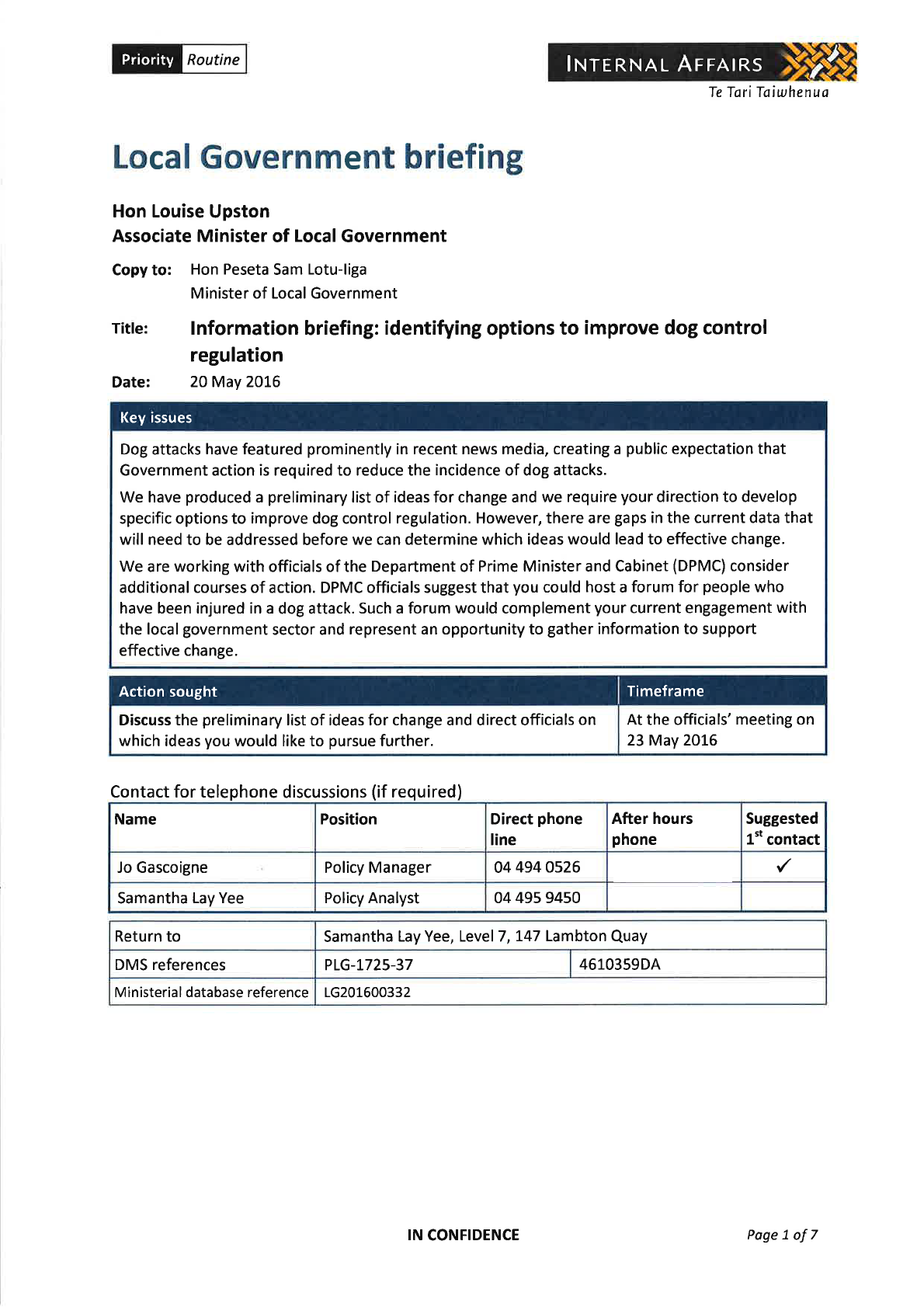
Document 3
ACT
INFORMATION
THE OFFICIAL
s. 9(2)(a)
SED UNDER
RELEASED UNDER THE OFFICIAL
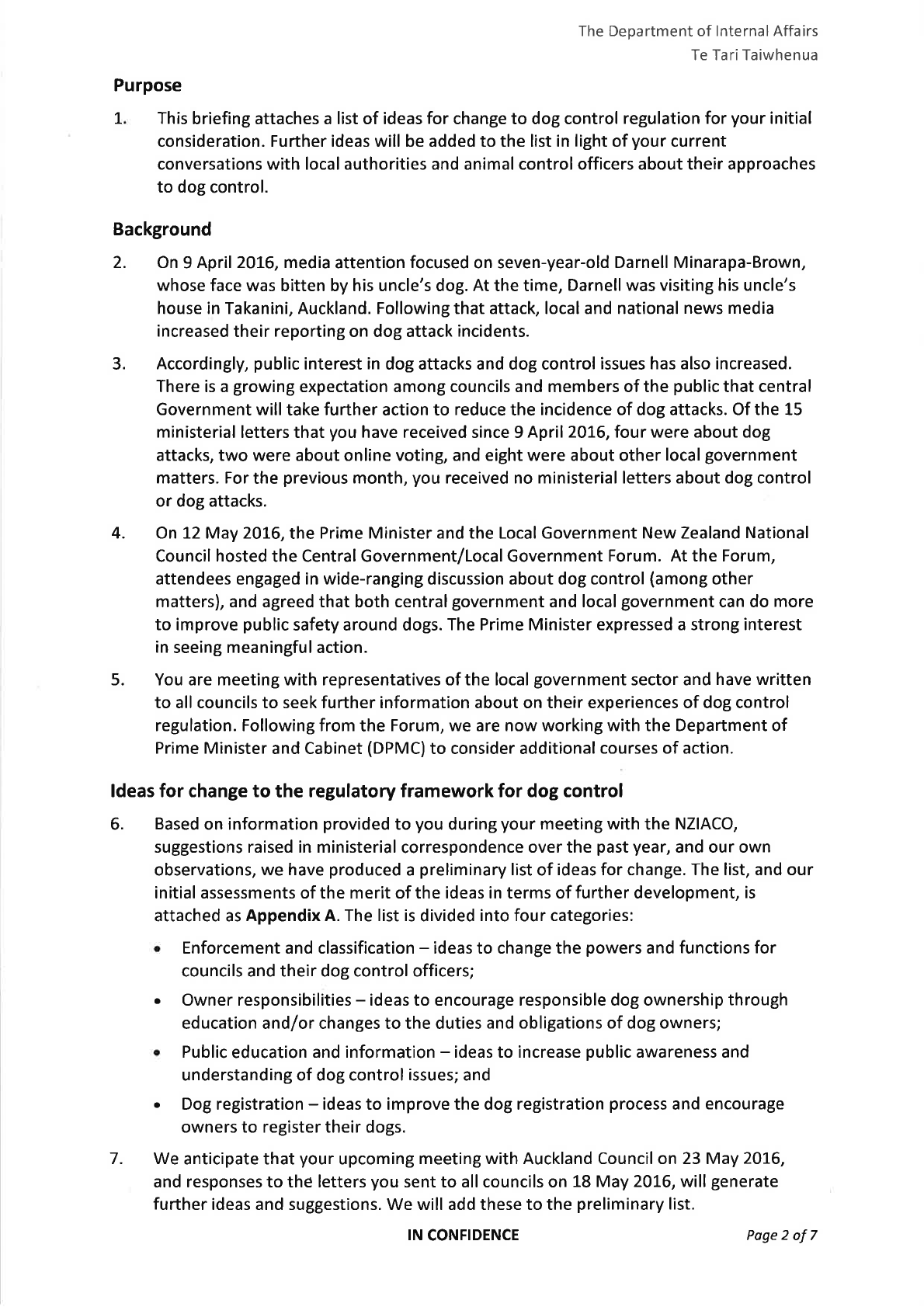
ACT
INFORMATION
THE OFFICIAL
SED UNDER
RELEASED UNDER THE OFFICIAL
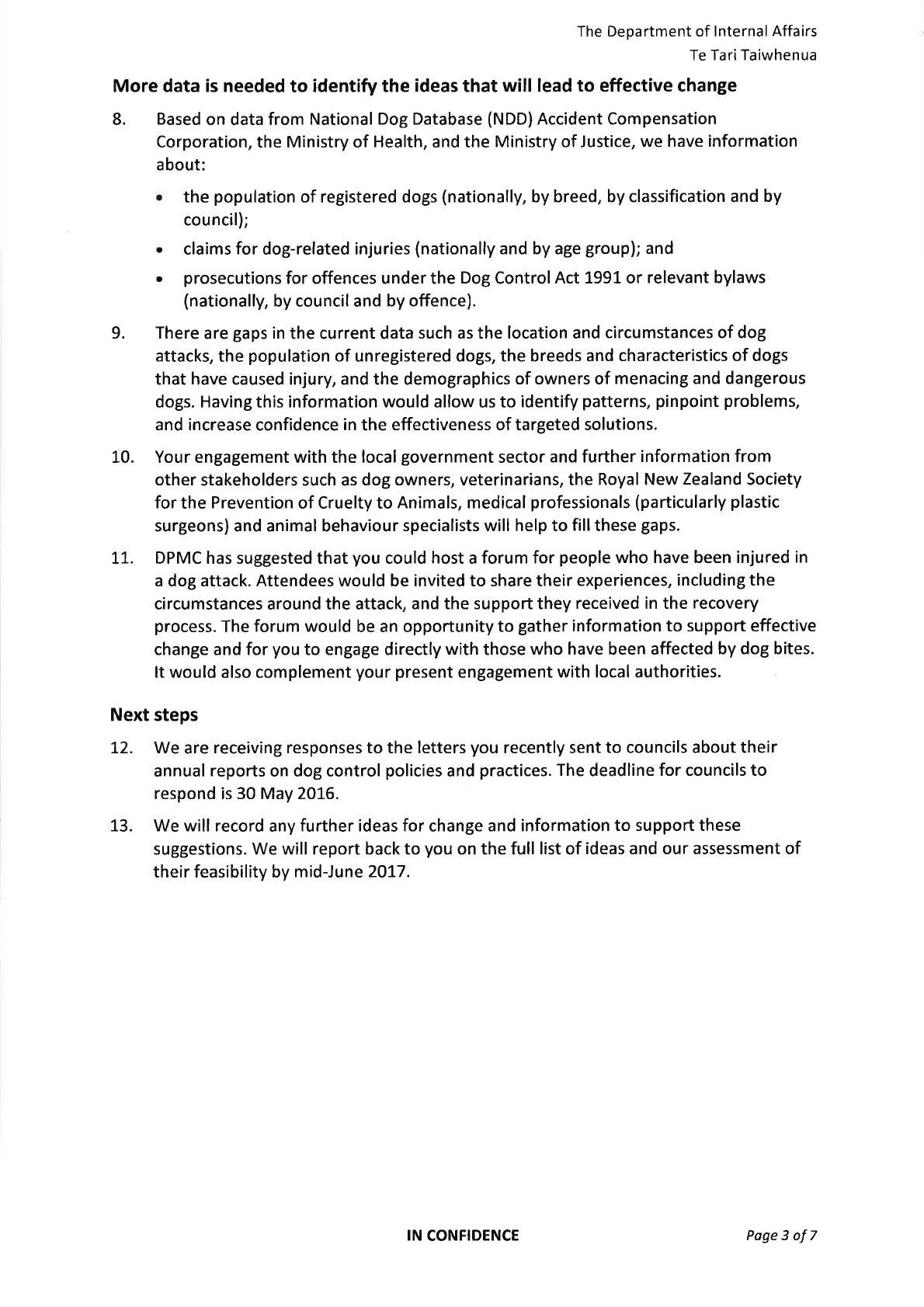
ACT
INFORMATION
THE OFFICIAL
SED UNDER
RELEASED UNDER THE OFFICIAL
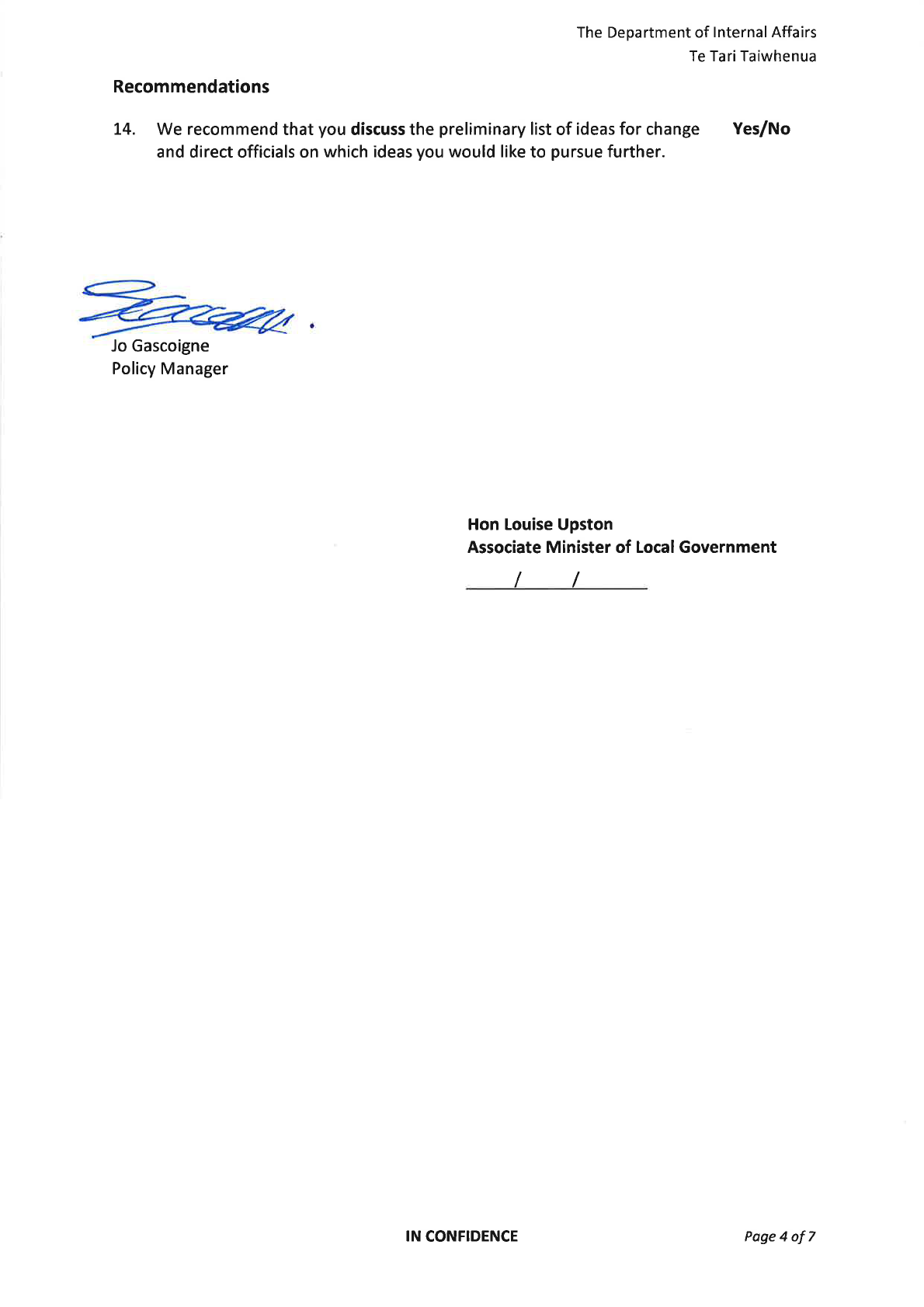
ACT
INFORMATION
THE OFFICIAL
SED UNDER
RELEASED UNDER THE OFFICIAL

ACT
INFORMATION
THE OFFICIAL
SED UNDER
RELEASED UNDER THE OFFICIAL
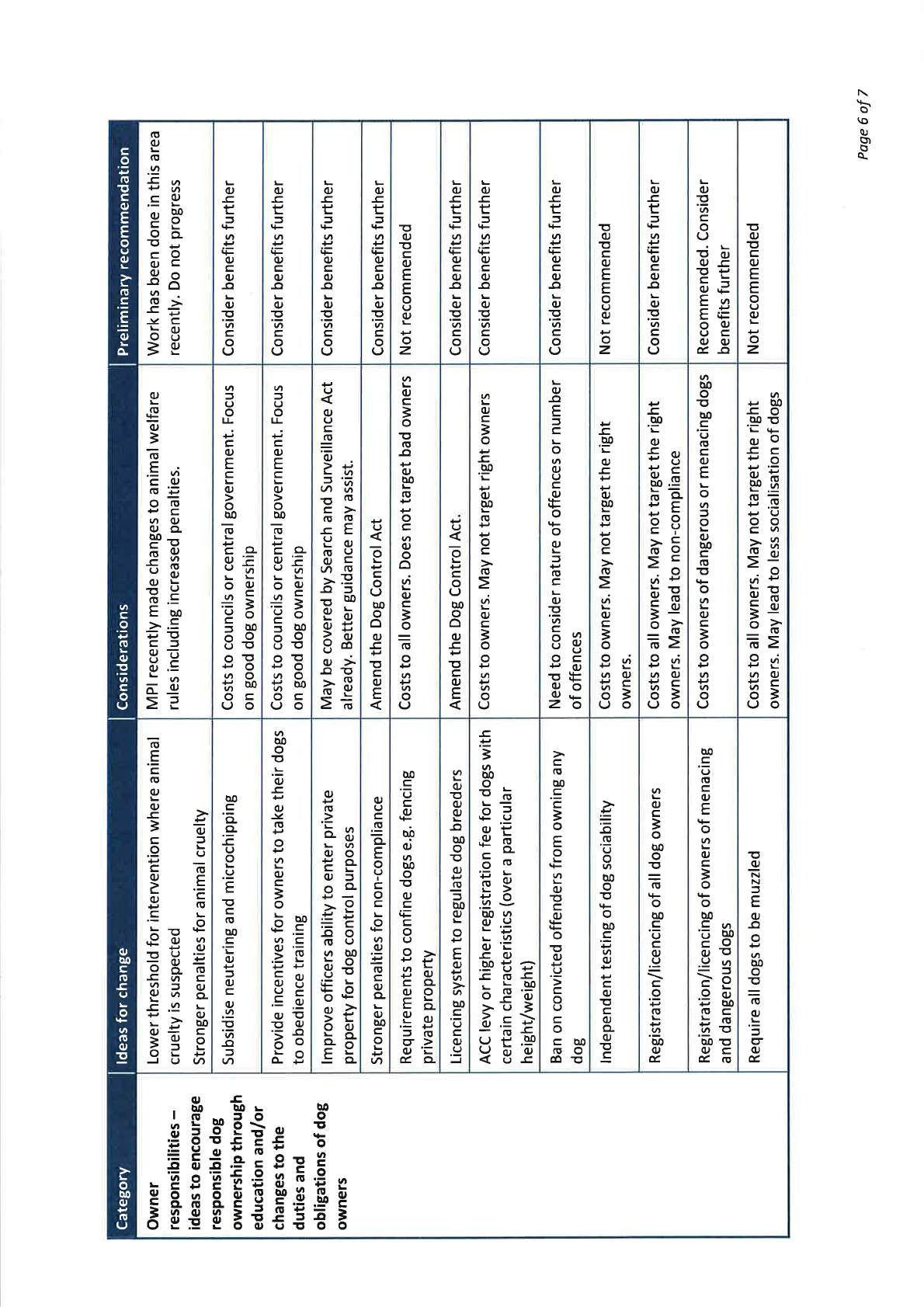
ACT
INFORMATION
THE OFFICIAL
SED UNDER
RELEASED UNDER THE OFFICIAL
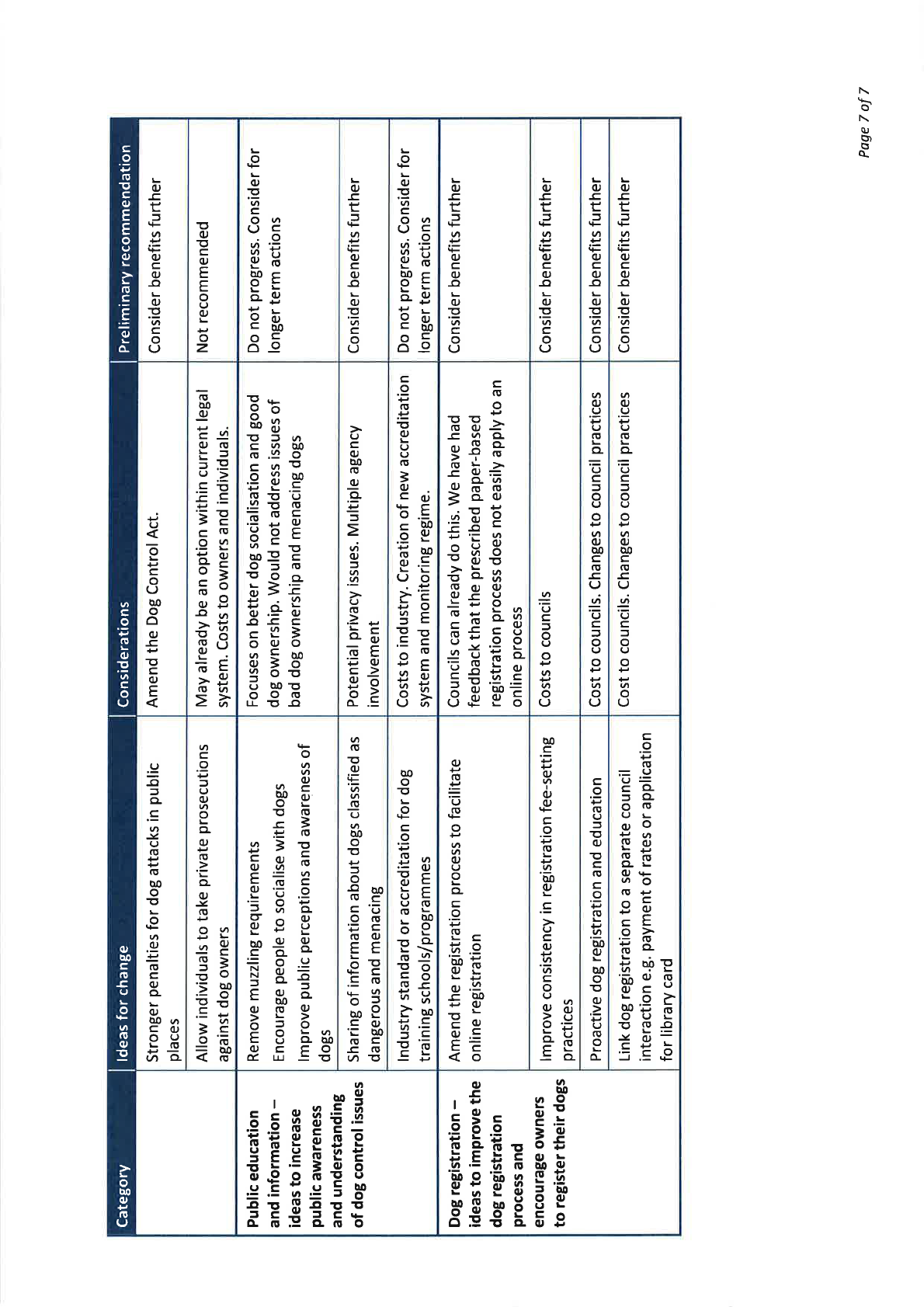
ACT
INFORMATION
THE OFFICIAL
SED UNDER
RELEASED UNDER THE OFFICIAL
ACT
INFORMATION
THE OFFICIAL
SED UNDER
RELEASED UNDER THE OFFICIAL
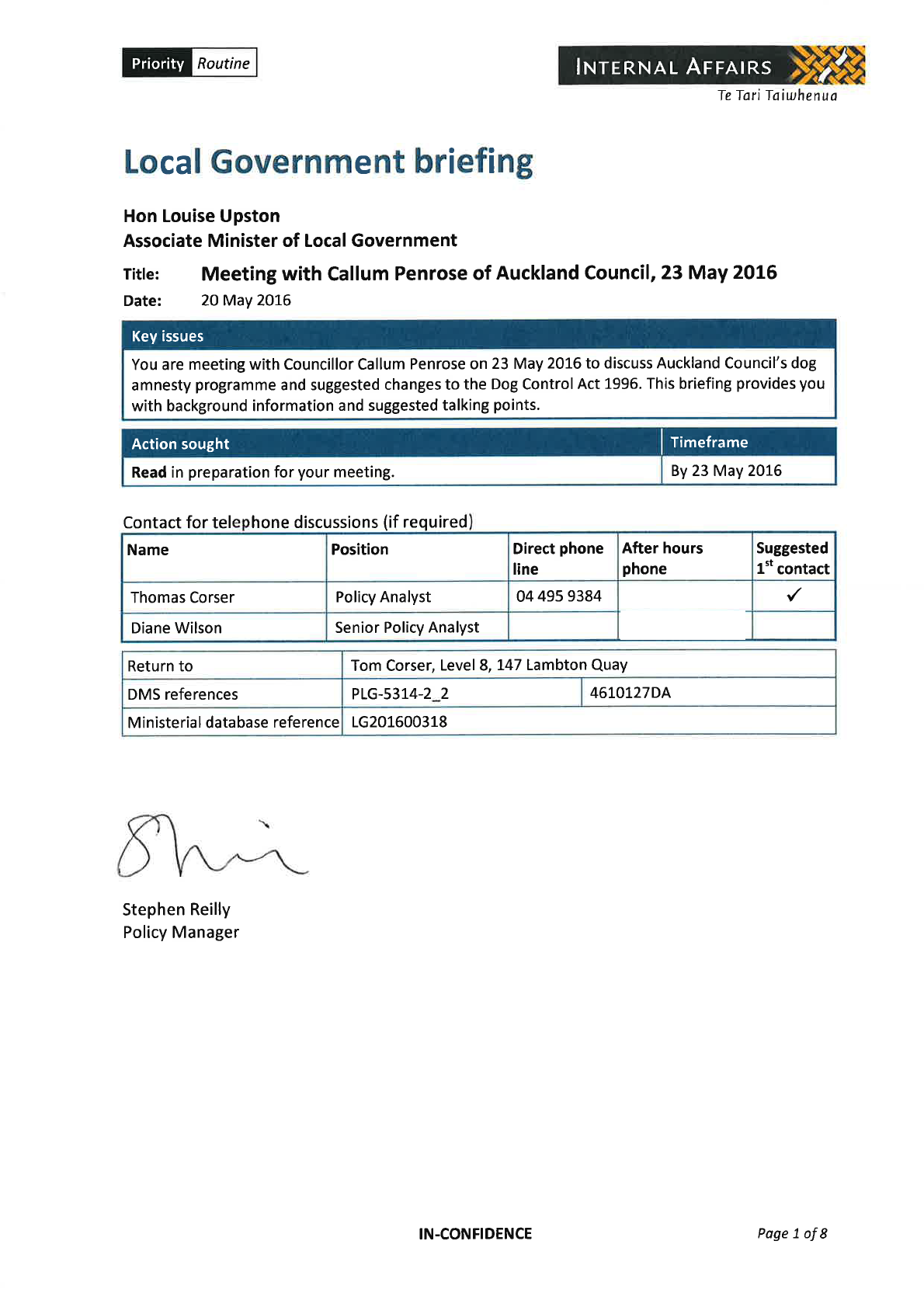
Document 4
ACT
INFORMATION
s.9(2)(a)
THE OFFICIAL
SED UNDER
RELEASED UNDER THE OFFICIAL
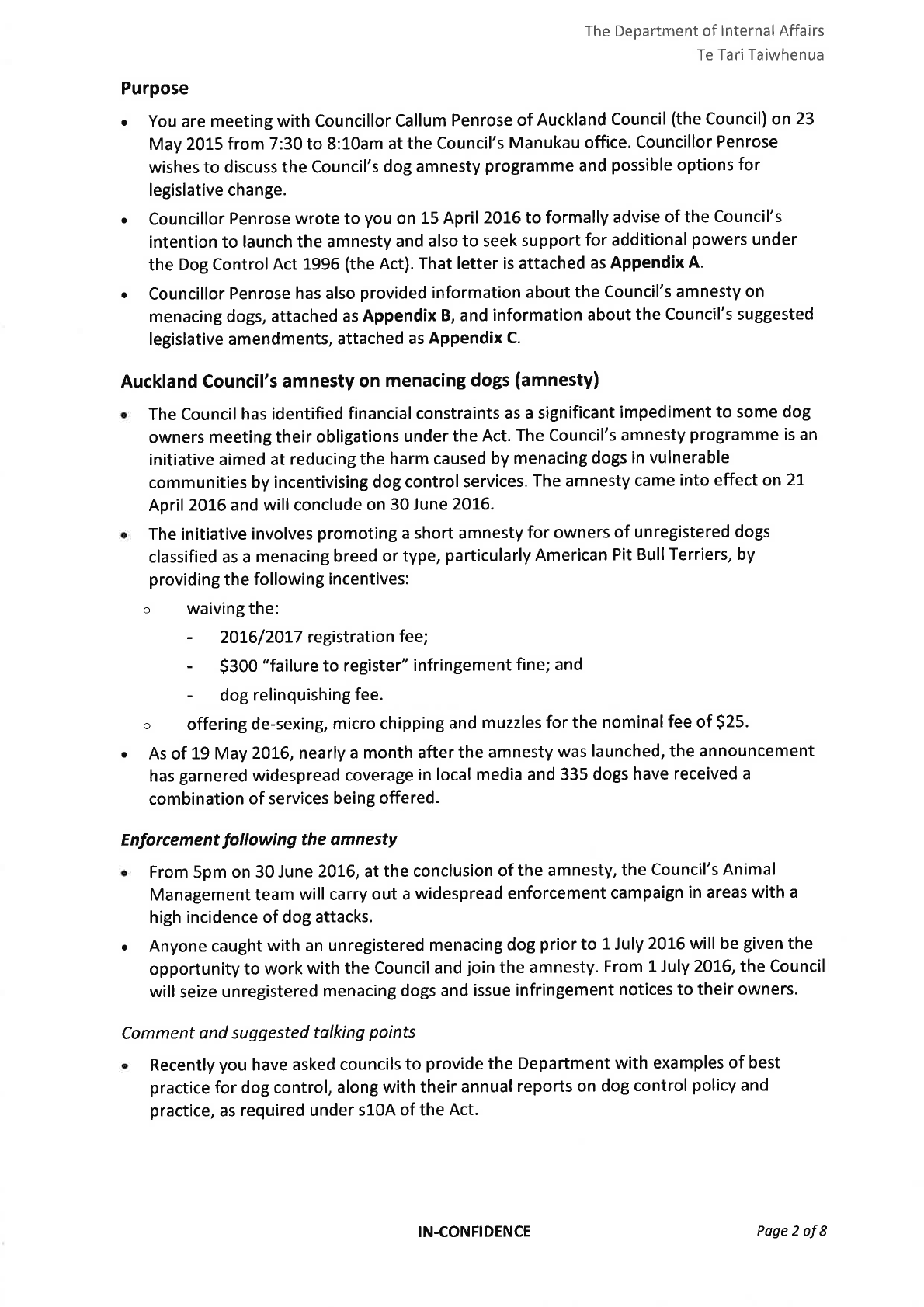
ACT
INFORMATION
THE OFFICIAL
SED UNDER
RELEASED UNDER THE OFFICIAL
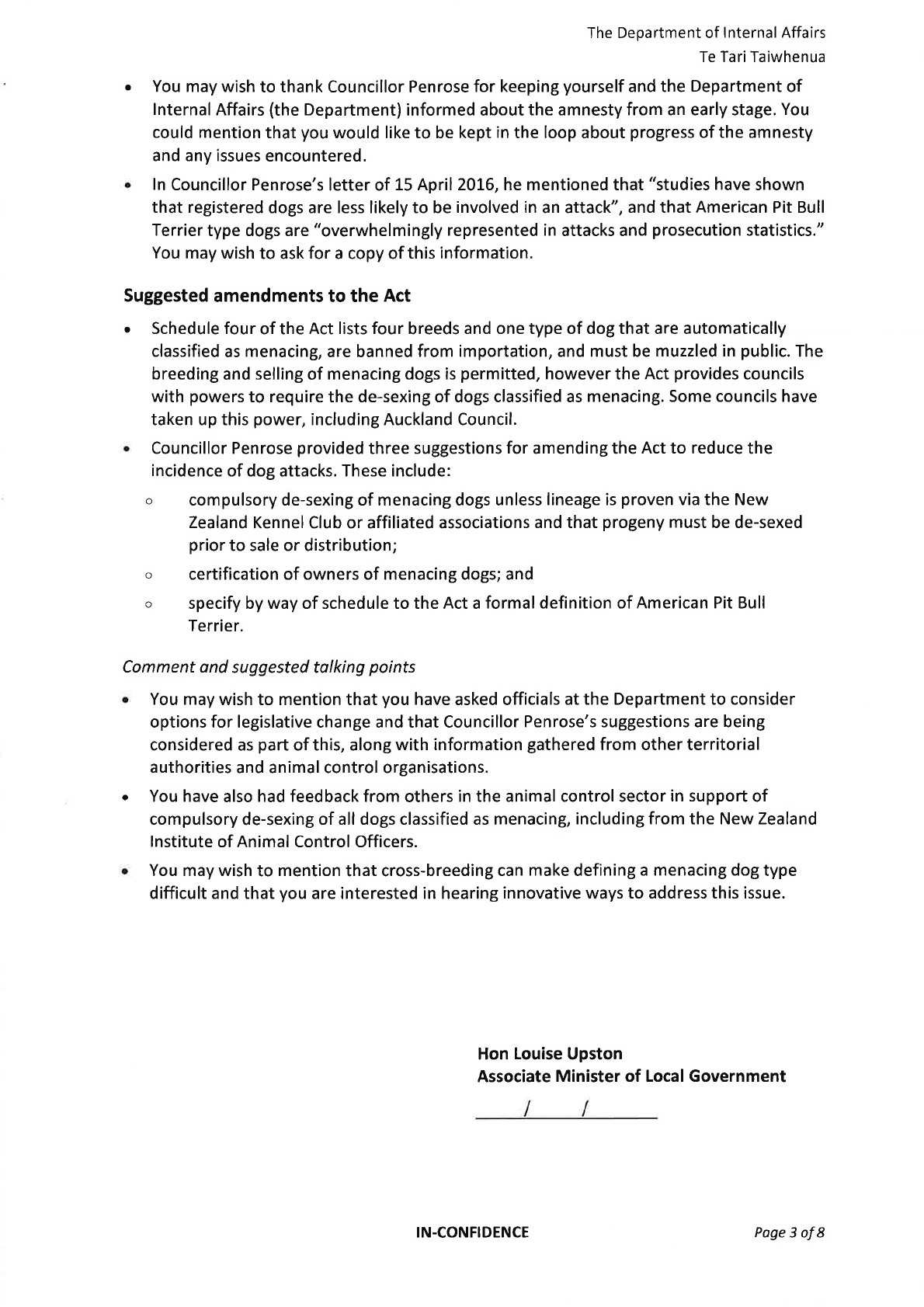
ACT
INFORMATION
THE OFFICIAL
SED UNDER
RELEASED UNDER THE OFFICIAL

ACT
INFORMATION
THE OFFICIAL
SED UNDER
LEASED UNDER THE OFFICIAL
RE
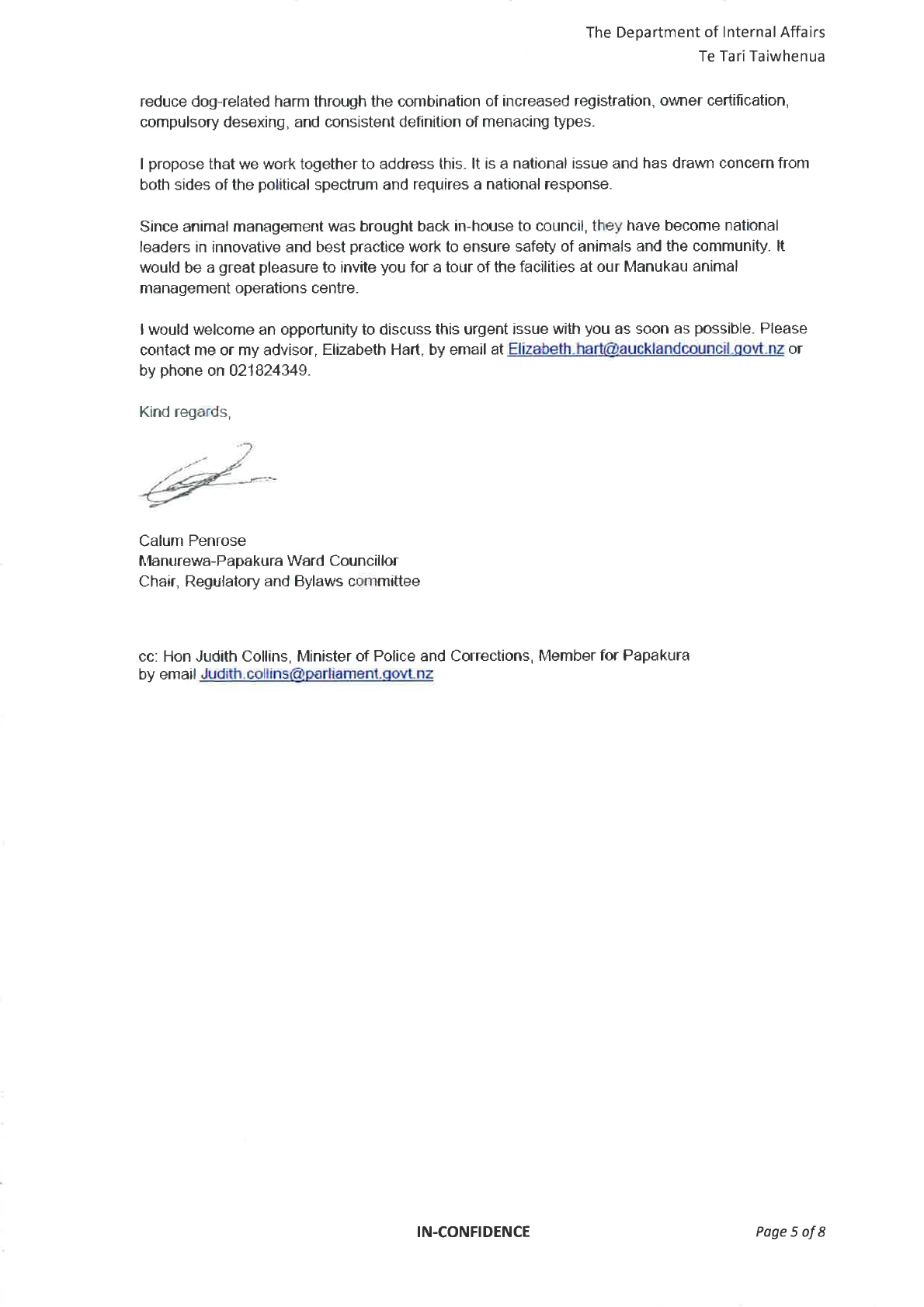
ACT
INFORMATION
THE OFFICIAL
SED UNDER
LEASED UNDER THE OFFICIAL
RE
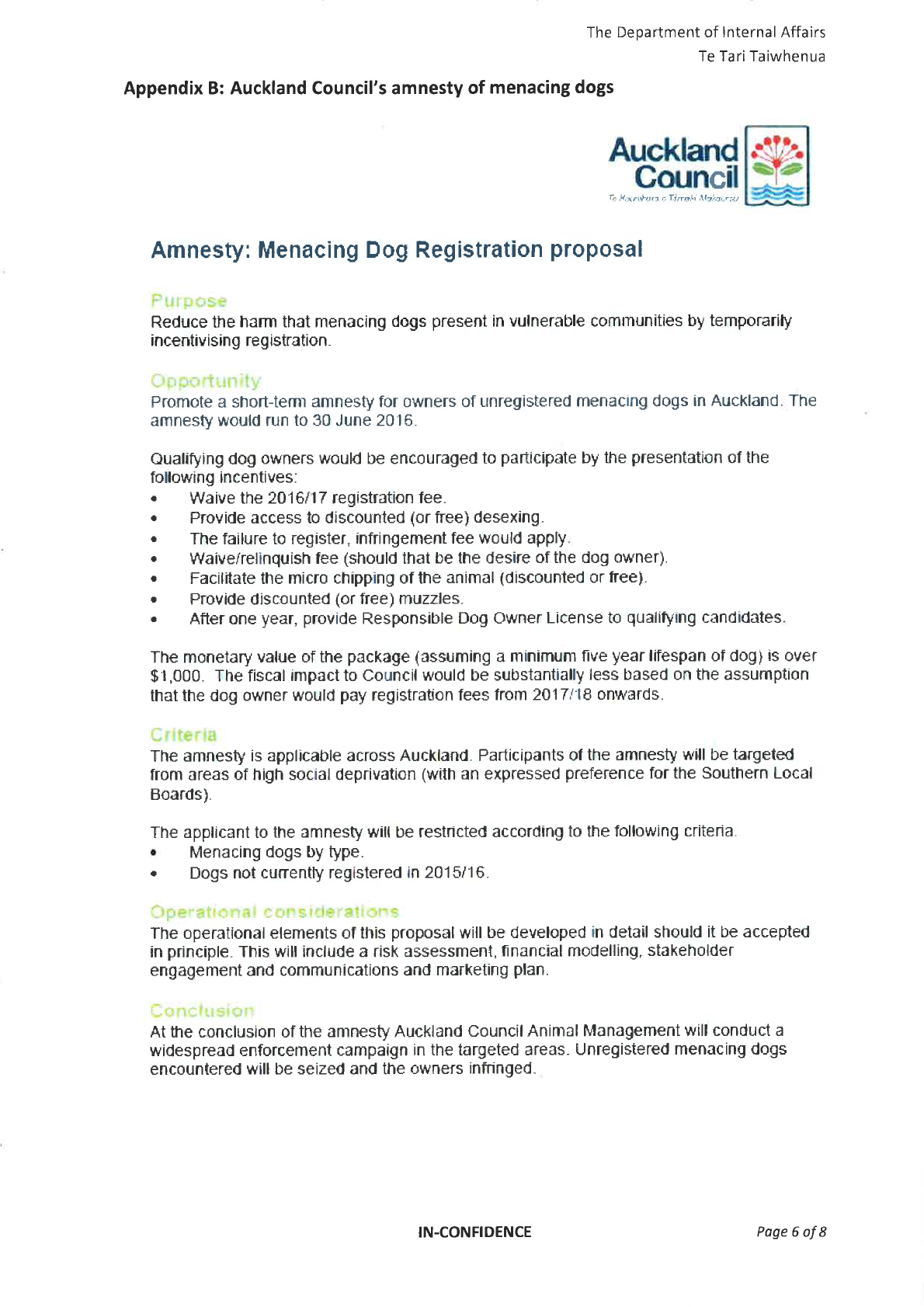
ACT
INFORMATION
THE OFFICIAL
SED UNDER
LEASED UNDER THE OFFICIAL
RE
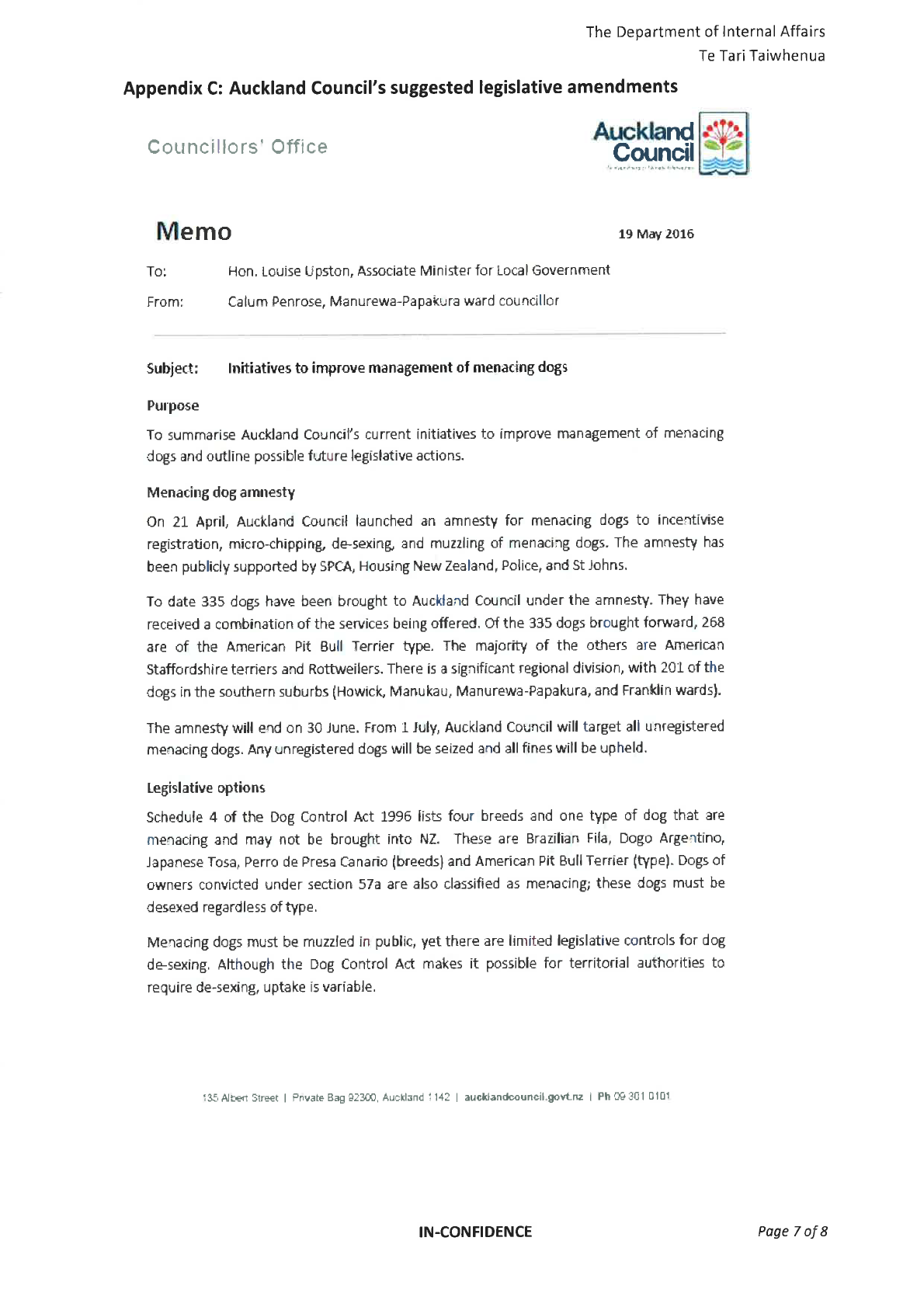
ACT
INFORMATION
THE OFFICIAL
SED UNDER
LEASED UNDER THE OFFICIAL
RE
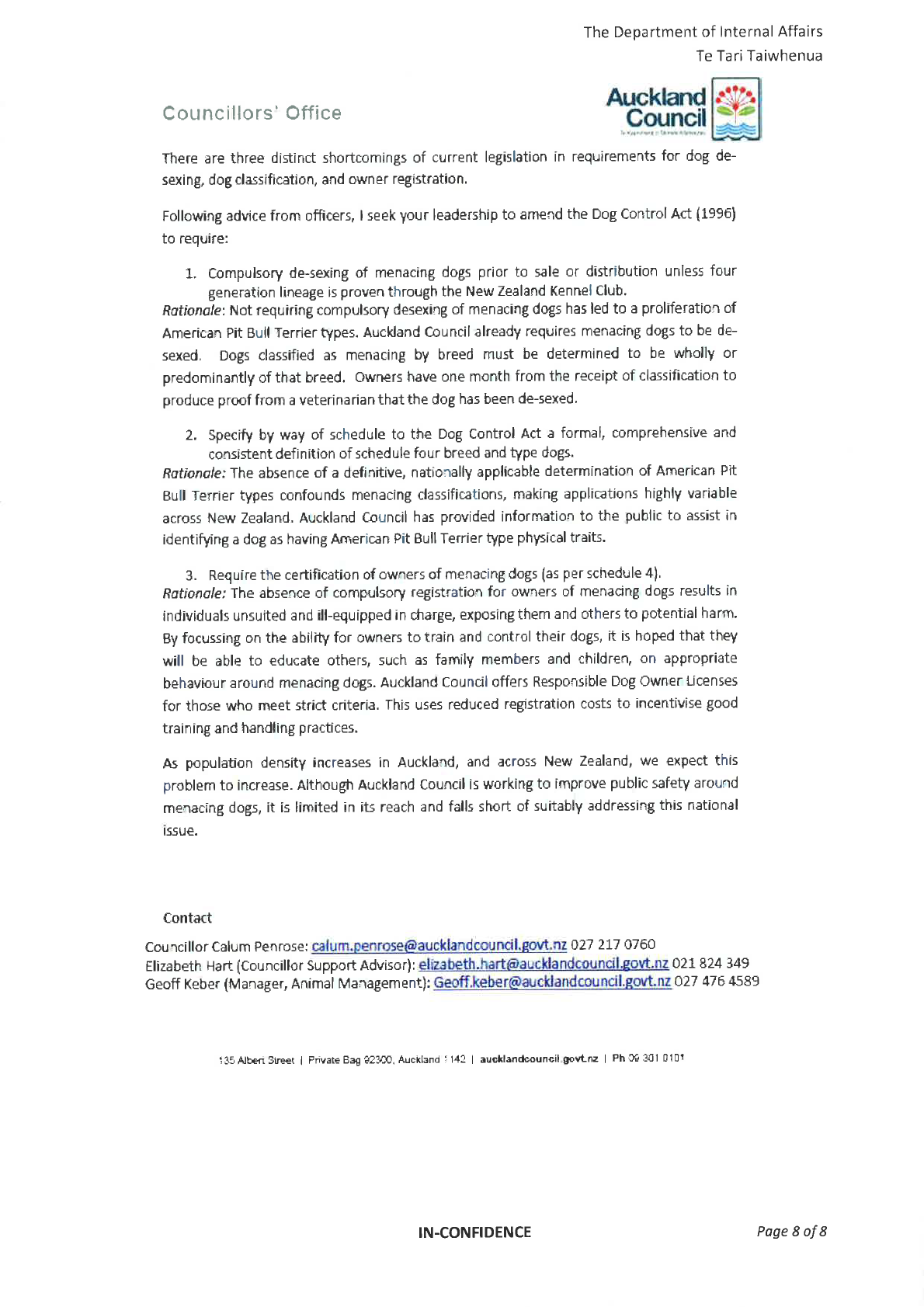
ACT
INFORMATION
THE OFFICIAL
SED UNDER
LEASED UNDER THE OFFICIAL
RE
Document 5
Proposed Amendments to Dog Control Act 1996
Do all TA’s have compulsory De-sexing for classified menacing
dogs by breed?
ACT
Territorial Authority comparison for the decision making for the compulsory de-
sexing of Menacing Dogs (41 Councils surveyed)
Do enforce de-
sexing
Do not enforce de-sexing
Number of councils
28
13
* This list is not inclusive of all NZ Councils
**Three Councils who currently do not enforce de-sexing are looking to change in their
next by-law review
INFORMATION
Territorial Authority Decision to include the American Staffordshire Terrier as a pit-bul
type (26 Councils surveyed)
A national law for the territorial authority to require dogs to be de-sexed under
section 33E would ensure consistency. This would avoid any confusion for owners
moving between territories and send a strong message to owners.
Is this a failure to de-sex and register problem?
THE OFFICIAL
Manukau Animal Shelter (MAS) Impounded 1/7/14 – 30/6/15
Total
Pit-bull types
Impounds
and x's
Impounds
4849
1803
SED UNDER
De-sexed at time of impound
822
46
De-sexed and registered at time
of impounding
389
2
LEASED UNDER THE OFFICIAL
De-sexed and known* at time of
impounding
256
91
RERegistered at time of impounding 910
236
Returned to owner
646
274
*Registered at some time, but not necessarily current (on council system)
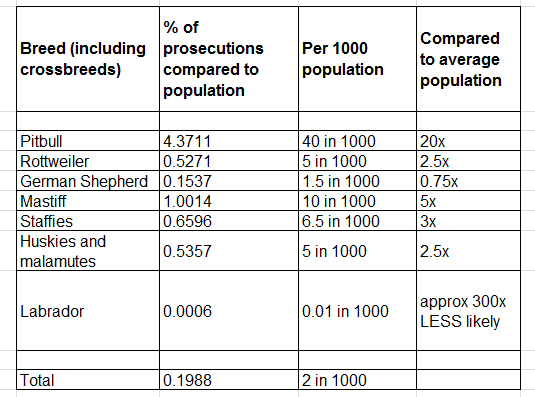
- 37% of total impounds at MAS during this period are of pit-bull type
(determined by shelter staff)
- 84% of total impounds were not de-sexed, 99.97% of pit-bull type dogs
impounded were not de-sexed
- 99.9% of menacing dogs impounded were not de-sexed and not currently
registered at the time of impound, compared with 92% of other breeds.
- 99.9% of menacing dogs were not de-sexed or known to council prior to ACT
impound
- 85% of menacing dogs did not get returned to owner
Are pit-bulls disproportionally represented in prosecution attacks?
Source: Auckland Council Prosecution attacks 1/11/2014 to 30/11/2015
INFORMATION
THE OFFICIAL
SED UNDER
LEASED UNDER THE OFFICIAL
RE
Are pit bulls types disproportionally represented in aggression
impounds?
MAS aggression impounds 1/7/2014 to 30/6/2015
Menacing
Section
type
Other breeds Total
Section 57 on people
162 = 61%
103
265
Section 57 on animal
149 = 68%
67
216
ACT
Section 57A
125 = 62%
76
201
Is there a National Standard for the determination of wholly or
predominantly of American Pit-bull type?
With the DCA 1996, amendments in 2006, the DIA produced the pit-bull matrix as a
national guideline to be used for the determination of the American pit-bull type dog.
This went out to all councils to use. Each council has then used this as a base
INFORMATION
however many have made their own variations to it
Recently Auckland Council and the Auckland SPCA have reviewed the matrix and
have a draft version in consideration which is intended to be used regionally by both
parties and potentially nationally. This is due for trial in the next few weeks.
Any new national standard definition would require consultation with all stakeholders.
Variations of ‘pit-bull type’ nationally.
THE OFFICIAL
For registration purposes Auckland Council recognises the American Staffordshire
Bull Terrier as being of Pit-bull type. Exceptions to this are if the dog owner can
provide NZKC paperwork verifying a four generation pedigree. This is not adopted
in all TA’s
Territorial Authority Decision to include the American Staffordshire Terrier
SED UNDER
as a pit-bul type (26 Councils surveyed)
Classify
LEASED UNDER THE OFFICIAL
(exempt
with NZKC
Classify - no
Do not
Officer
RE
paperwork) exemptions
classify
discretion
Number of
Councils
4
9
12
1
* This list is not inclusive of all NZ Councils
What could a certified owner look like?
Pit-bull terrier type dogs have been bred to eliminate submission inhibition. Their
genetic code means that they will continue to attack once their adversary has
submitted.
ACT
Because they are large muscular dogs they are therefore far more likely to cause
significant damage.
De-sexing at an early age may reduce this propensity, however it will not eliminate it,
and the dogs environment is critical to reducing the risk associated with owning one
of these dogs.
Therefore, we believe that it is critical that people that want to own these dogs are
certified by way of an accredited training program prior to getting these dogs.
INFORMATION
There are providers such as Mark Vette, internationally renowned dog behaviourist,
who run programs that could be used as a basis for accreditation.
One component of certification could include greater obligations on these dog
owners if they move addresses, to display a sign that a menacing dog is on the
property, the dog is not left alone with anyone under the age of 16 and the wearing
of special identification collars. We would also seek corresponding powers if these
conditions were breached.
THE OFFICIAL
In Queensland, people must apply for a permit to obtain a restricted dog.
SED UNDER
LEASED UNDER THE OFFICIAL
RE

Document 6
Councillors’ Office
By email: [email address]
30 May 2016
Dear Minister
It was a pleasure to meet with you on Monday, 23 May 2016. Thank you for making the time to v sit
our Animal Management Operation centre in Manukau. Thank you too for your letter to His
ACT
Worship the Mayor dated 19 May 2016.
I was encouraged to hear your views on the impact of menacing dogs in vulnerable communities.
Your support of Auckland Council’s amnesty and subsequent crackdown is greatly appreciated. I
have reflected on your request for further suggestions as to how we might work together to control
menacing and dangerous dogs and offer my thoughts below. I think you will find them practical and
enforceable.
1. Formal identification of menacing or dangerous dogs
•
Require owners of dangerous or menacing dogs to display the classification by a specifically
coloured collar that clearly identifies the dog as such.
INFORMATION
Any dogs not wearing those collars would be subject to impounding and held until the territorial
authority is satisfied that the owner will fully comply with all conditions of the classification. Failure
to do so would result in forfeiture of the animal within 3 days.
•
Properties where a dog classified as dangerous or menacing is domiciled must display a
prescribed sign at each entrance to the property warning the public of the animals’ presence.
Any classified dog held properties not displaying specified signage would be subject to impounding
and held until the territorial authority is satisfied that the owner will fully comply with all conditions
of the classification. Failure to do so would result in forfeiture of the animal within 3 days.
THE OFFICIAL
2. Probationary or disqualified ownership
•
Simplify the ability of a territorial authority to classify a dog owner as probationary or
disqualified.
My suggestion is to reduce this to either two or more offences (not relating to a single incident or
occasion) within 24 months, or 3 or more offences (relating to two or more occasions) within a
continuous period of 24 months.
SED UNDER
3. Fencing
•
All dogs that are classified as menacing or dangerous must be kept in a fenced portion of the
LEASED UNDER THE OFFICIAL
property to enable visitors to come to the front door without fear of being attacked and for
children to play without interaction with the dog.
RE
Properties that are inspected and not compliant would cause the dogs to be impounded and held
until the territorial authority is satisfied that the owner will fully comply with all conditions of the
classification. Failure to do so would result in forfeiture of the animal within 3 days.
135 A bert Street | Private Bag 92300, Auckland 1142 |
aucklandcouncil.govt.nz |
Ph 09 301 0101
 4. Compulsory de-sexing of menacing or dangerous dogs within 14 days
4. Compulsory de-sexing of menacing or dangerous dogs within 14 days
•
Any dogs classified as menacing or dangerous must be de-sexed and micro chipped within 14
days of being classified.
Any dogs classified as menacing that are impounded would be required to be de-sexed and micro
chipped at the owner’s expense prior to release from the shelter. Failure to do so would result in
forfeiture of the animal within 3 days, rather than the current 7 day allowance.
5. Single definition of schedule 4 breed and type dogs
•
Specify by way of schedule to the Dog Control Act a formal, comprehensive and consistent
definition of schedule four breed and type dogs.
ACT
6. Certification of owners
•
Any person who owns or possesses a menacing or dangerous dog must obtain certification
from a trainer approved by a territorial authority.
Any menacing or dangerous dog found in possession of a person without the certification is subject
to impounding and the dog held until that Territorial Authority believes the owner will comply with
the conditions of the classification. Failure to do so will result in forfeiture of the animal within 3
days.
•
Any children under the age of 14 years must not be left alone with a menacing or dangerous
INFORMATION
dog.
Any menacing or dangerous dog found alone with children under the age of 14 years is subject to
impounding and held until the territorial authority is satisfied that the owner will fully comply with all
conditions of the classification. Failure to do so would result in forfeiture of the animal within 3
days.
7. Reduction in holding periods in shelters
•
The owner of any menacing dog that is impounded must pay the any outstanding fees
within 3 days.
Failure to do so would result in forfeiture of the animal.
THE OFFICIAL
Finally Minister, your letter draws my attention to an unfortunate oversight. Auckland Council
moved at the October 2015 meeting of the Regulatory and Bylaws Committee that the 2014-2015
Animal Management Annual Report be accepted. However, unfortunately and regrettably, the
report was not provided to the Department of Internal Affairs as per section 10A of the Dog Control
Act 1996. I have been advised that it was sent electronically to the Secretary of Local Government
on 25 May.
Thank you again for your time Minister. I look forward to continuing to work with you to minimise
SED UNDER
the risk and harm to that menacing dogs present.
LEASED UNDER THE OFFICIAL
Kind regards,
RE
Calum Penrose
Manurewa-Papakura Ward Councillor
Chair, Regulatory and Bylaws committee
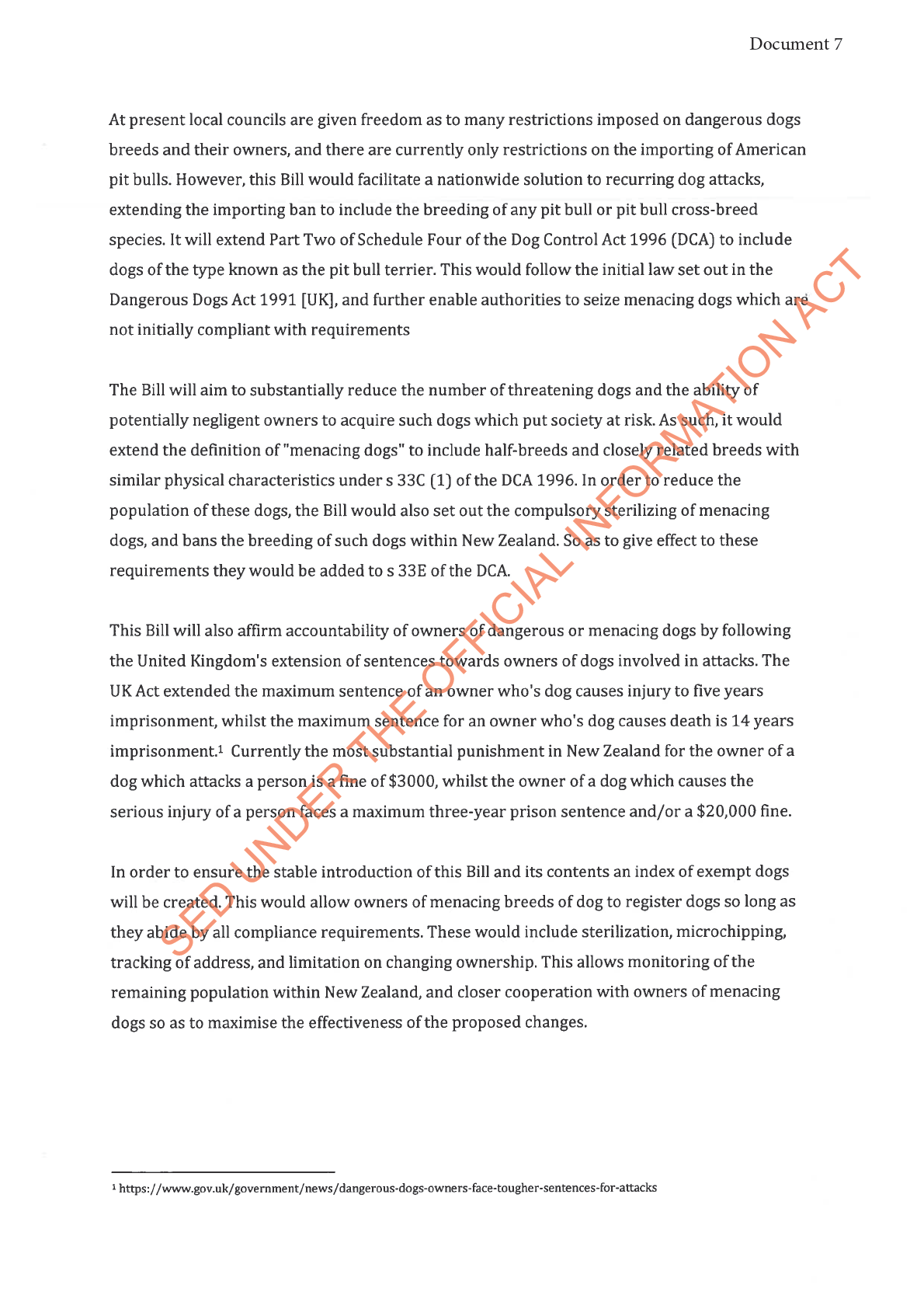
ACT
INFORMATION
LEASED UNDER THE OFFICIAL
RE
ACT
INFORMATION
THE OFFICIAL
SED UNDER
LEASED UNDER THE OFFICIAL
RE
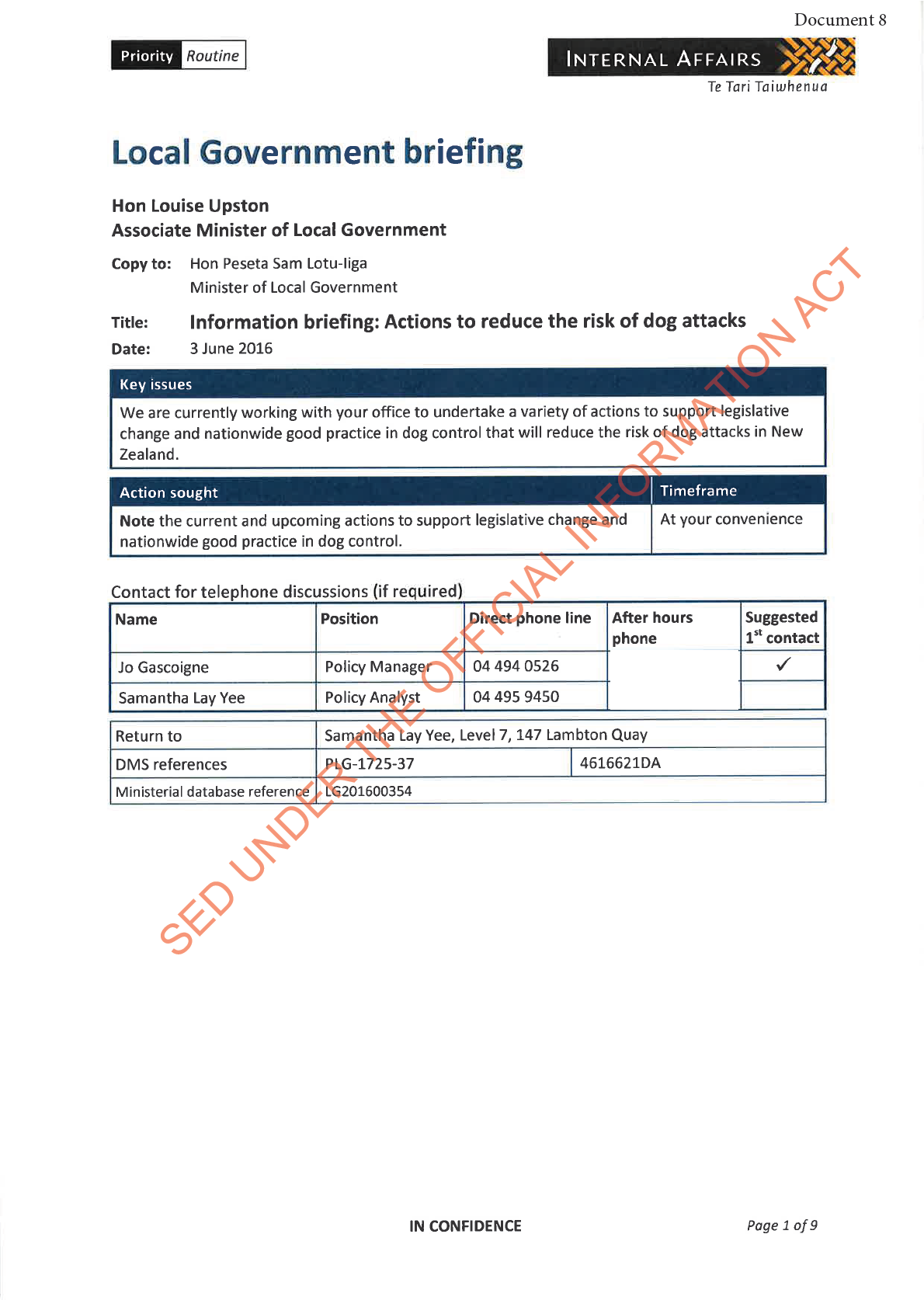
ACT
INFORMATION
s.9(2)(a)
LEASED UNDER THE OFFICIAL
RE
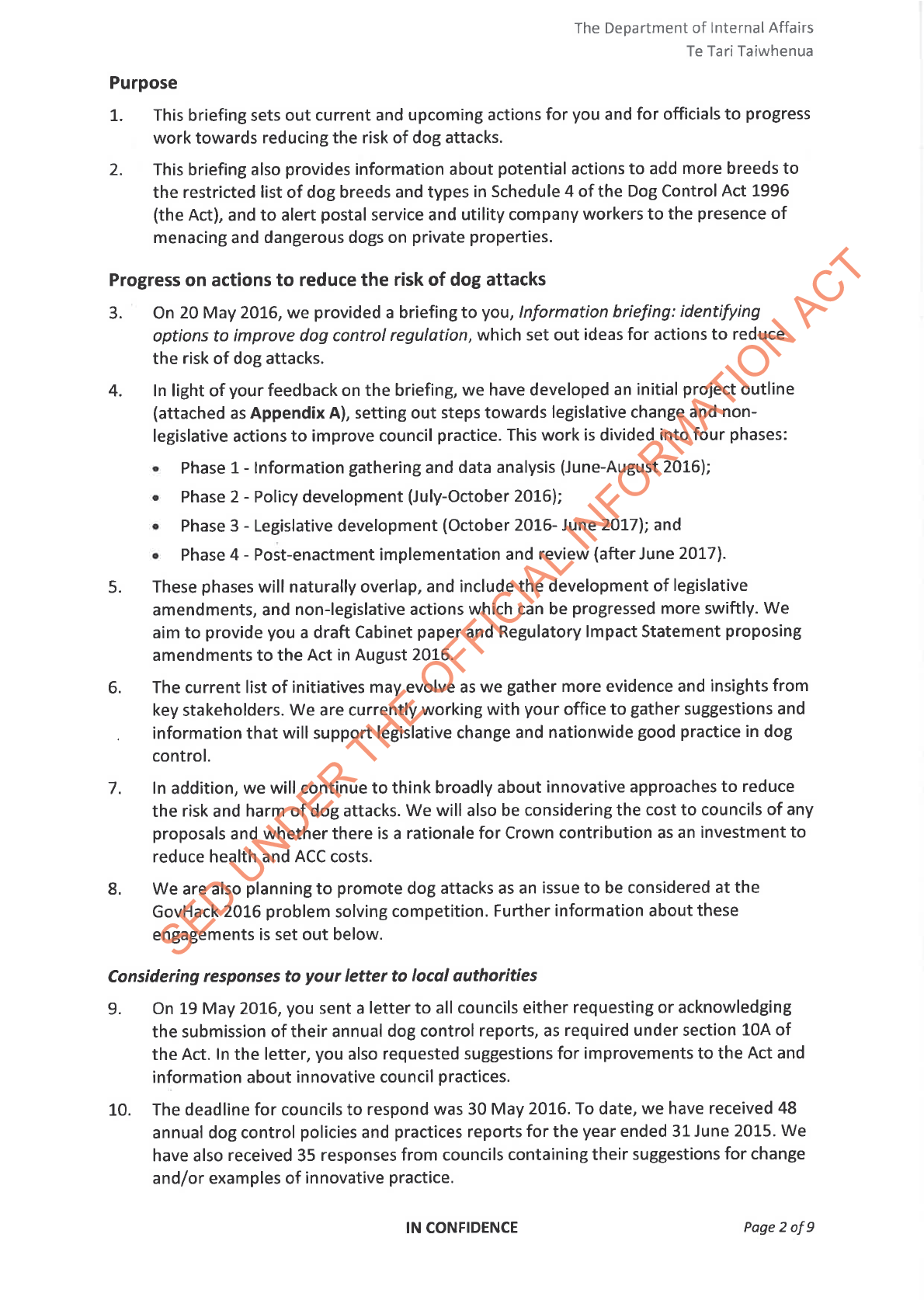
ACT
INFORMATION
LEASED UNDER THE OFFICIAL
RE
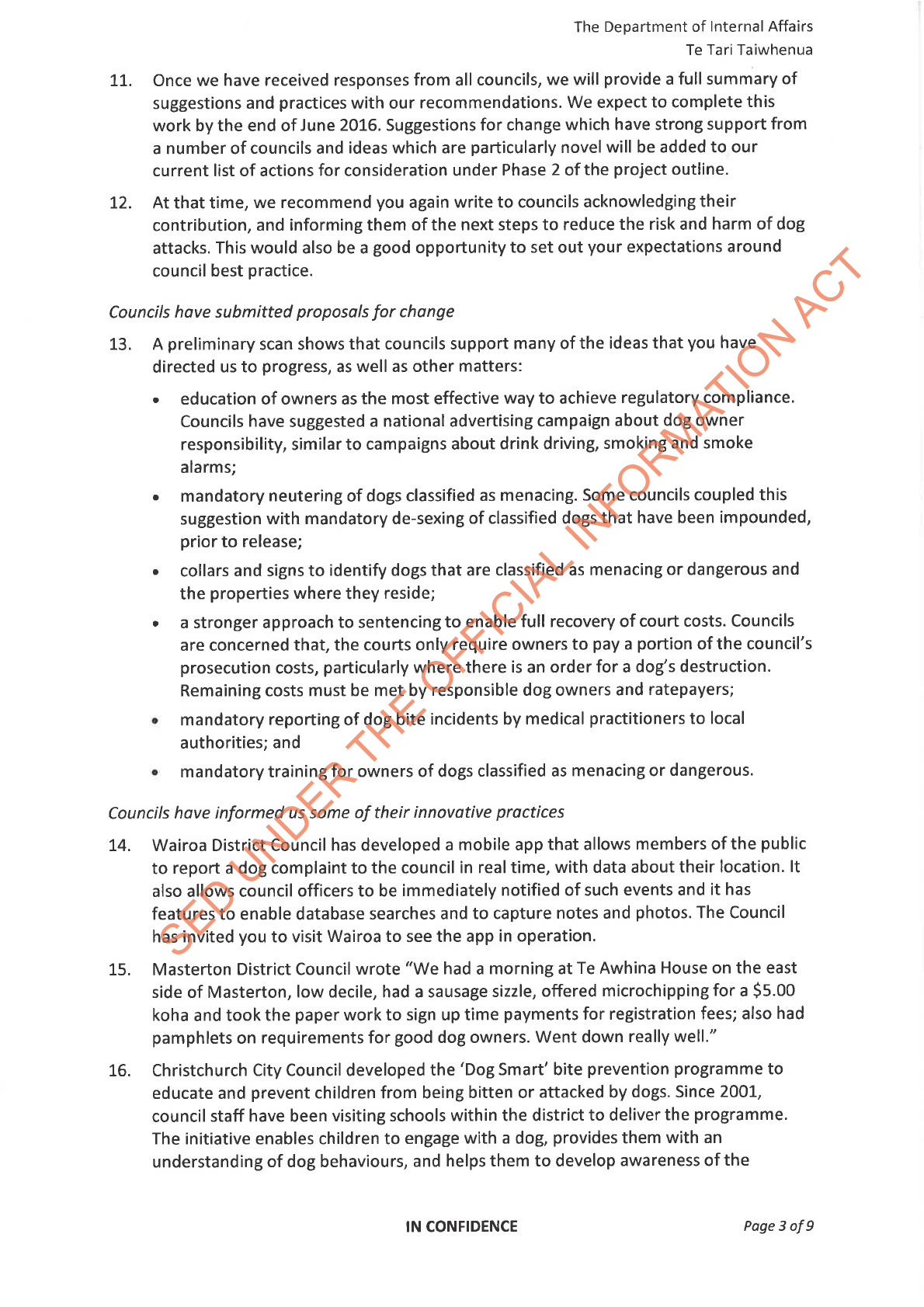
ACT
INFORMATION
LEASED UNDER THE OFFICIAL
RE
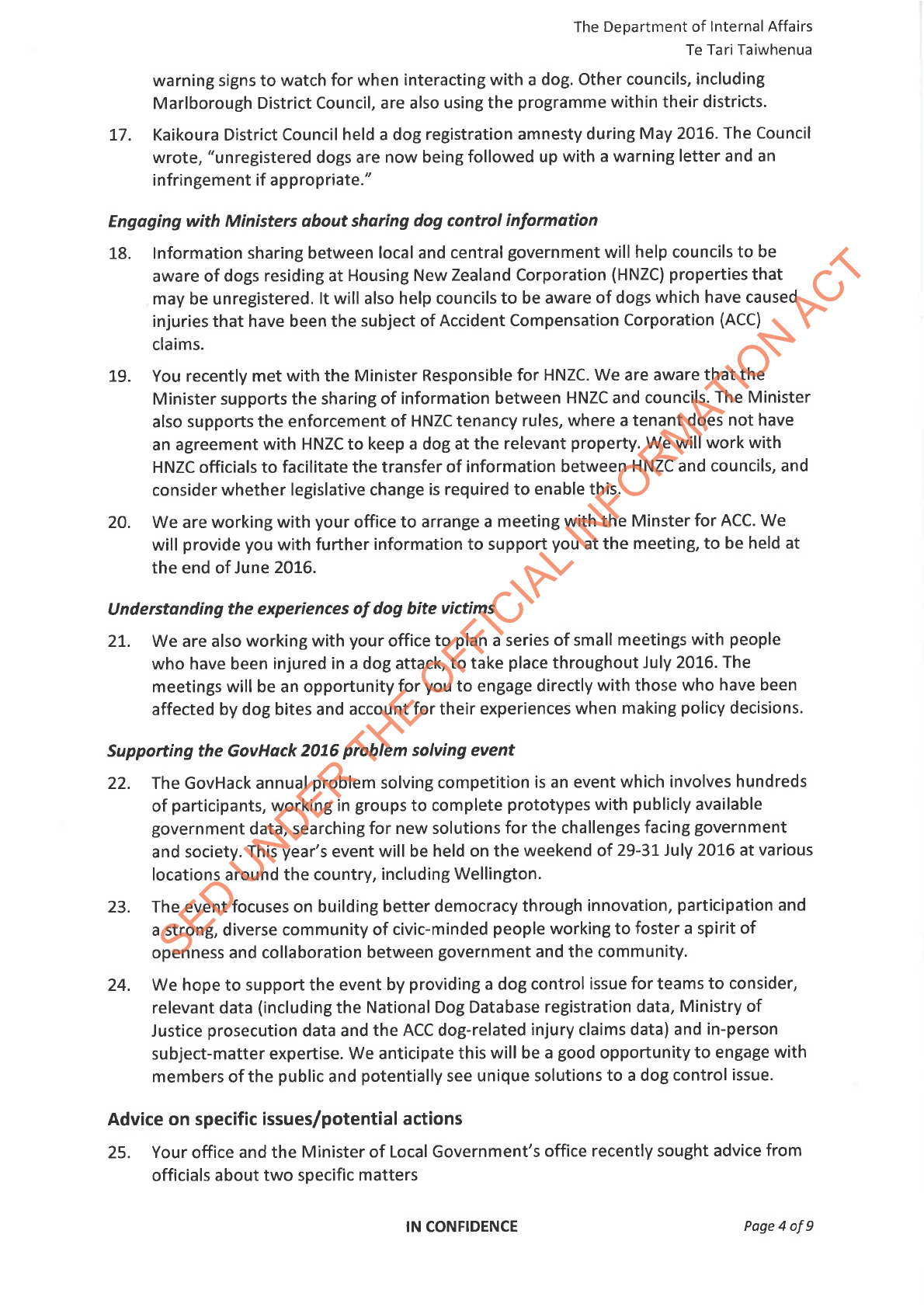
ACT
INFORMATION
LEASED UNDER THE OFFICIAL
RE
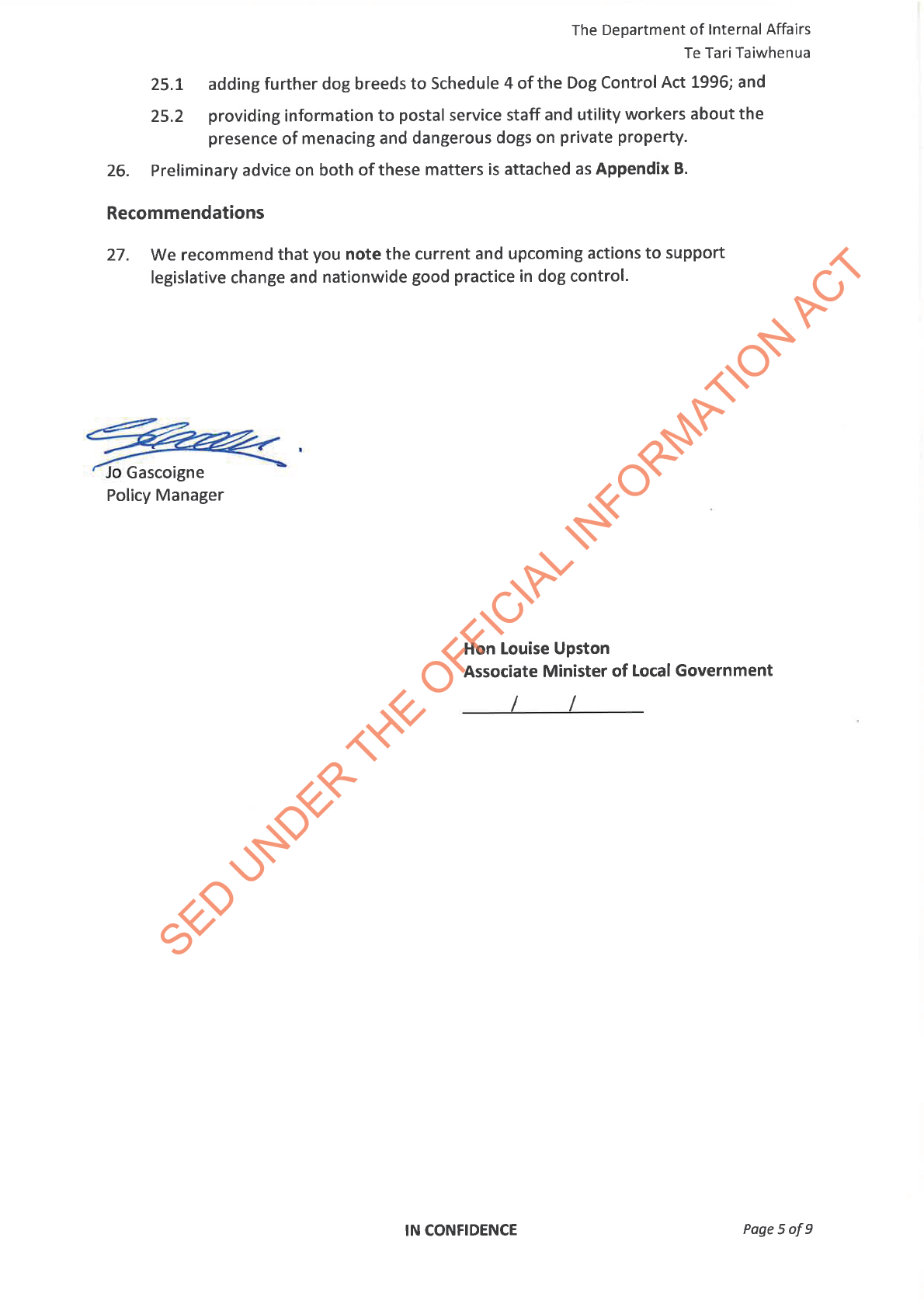
ACT
INFORMATION
LEASED UNDER THE OFFICIAL
RE
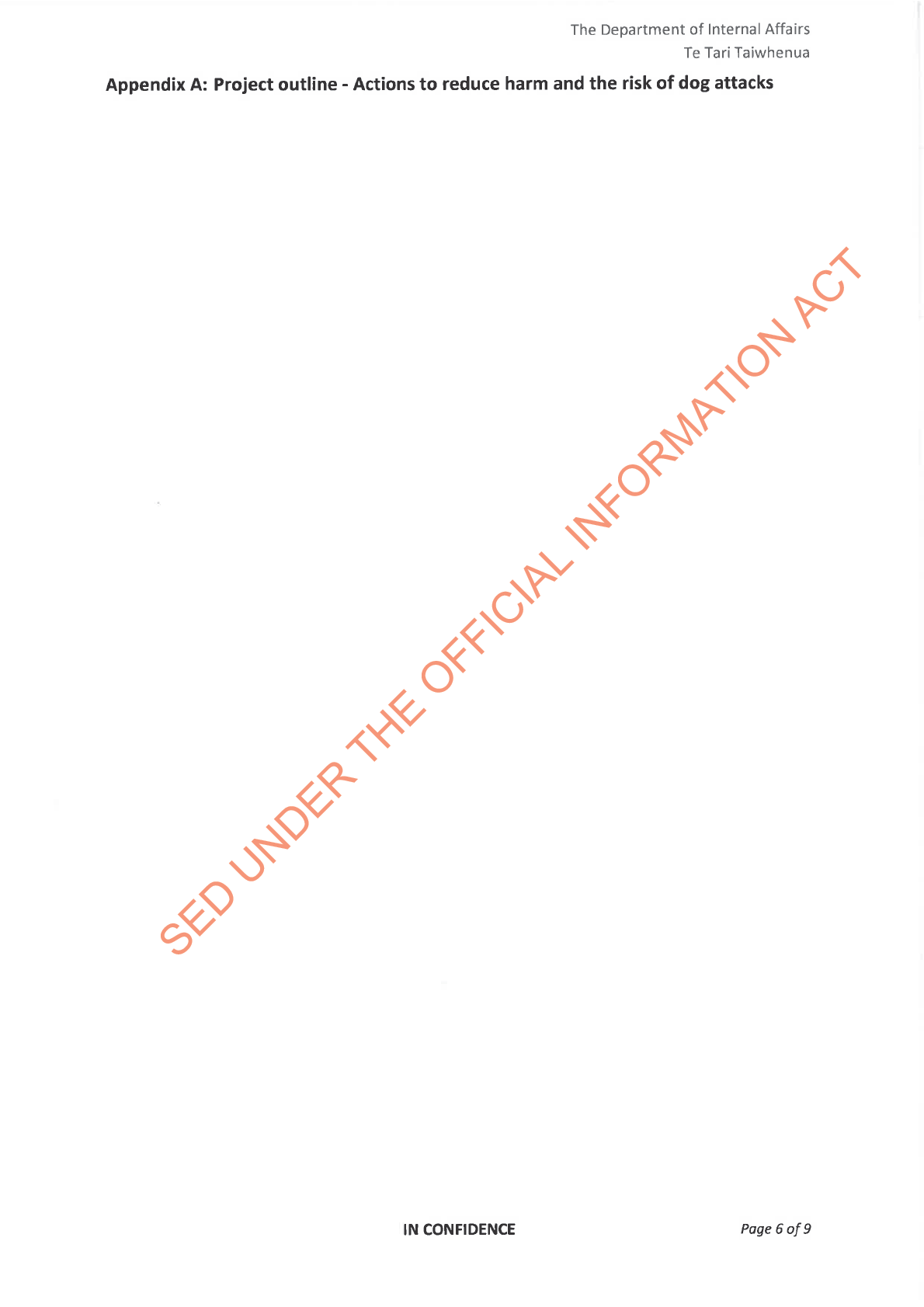
ACT
INFORMATION
LEASED UNDER THE OFFICIAL
RE
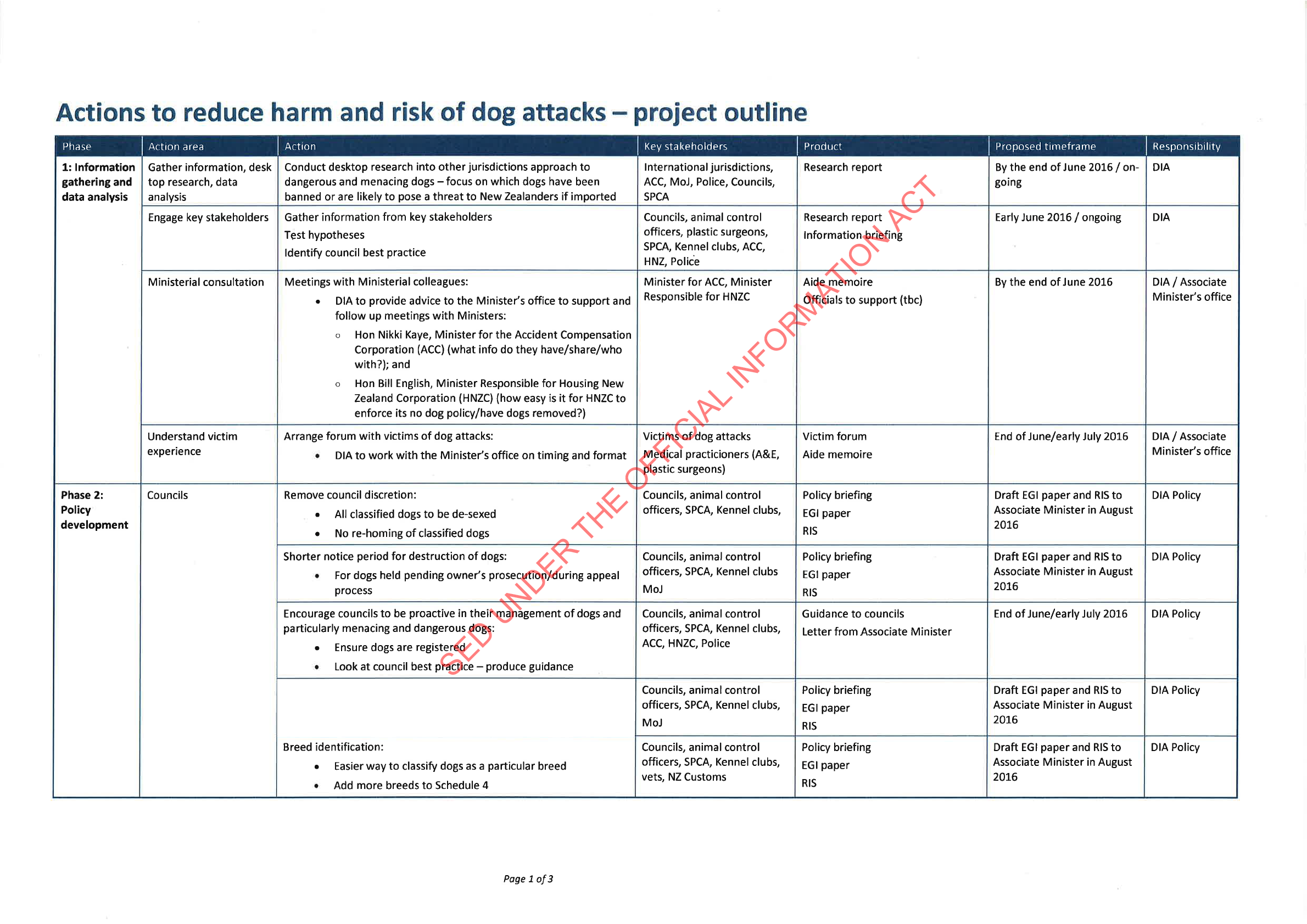
ACT
INFORMATION
s.9(2)(f)(iv)
LEASED UNDER THE OFFICIAL
RE
